本文整合了中文维基百科和英文维基百科中“泛亚铁路(东南亚)”词条的内容。英文词条的内容配有辽观提供的参考译文,仅供参考。
中文词条原文链接(无法从中国内地访问):请点击这里访问
英文词条原文链接(无法从中国内地访问):请点击这里访问辽观搬运的中英文维基百科词条,文本与原维基百科词条文本同样遵循CC-BY-SA 4.0协议,在符合协议要求的情况下您可以免费使用其内容(包括商用)。图片可能遵循不同的共享协议。
维基百科(Wikipedia)是美国维基媒体基金会的互联网百科项目,其内容可能受到立场、信息来源等因素影响,请客观看待。正文内容不代表译者观点。
文中可能包含无法从中国内地访问的链接。本文涉及的共享协议
封面图片:Connections in Southeast Asia, built (black), projected (yellow) and yet to open (red).
(东南亚的连接,已建成(黑色),计划(黄色),尚未开放(红色)。)
图片作者:Classical geographer – 此图片遵循CC BY-SA 3.0协议
泛亚铁路东南亚段,又称昆明-新加坡铁路,是链接中国、中南半岛、马来半岛和新加坡之间的铁路网[1]。1995年12月,时任马来西亚首相马哈迪·莫哈末在东盟第五届首脑会议上提议修建由中国昆明经老挝、泰国、马来西亚到新加坡的国际铁路,之后陆续得到有关国家的赞同,故被称为“泛亚铁路”。2006年10月,各个东南亚国家签署了“泛亚铁路网协议”,将昆明 – 新加坡铁路纳入泛亚铁路的计划中。该铁路计划在三十年内完成,总投资估计超过20亿美元,中国大陆计划投资128亿元人民币。
2021年12月,中线玉溪~磨憨与磨丁~万象段开通,标志着昆明至新加坡的铁路链接实现部分开通。
The network consists of three main routes from Kunming, China to Bangkok, Thailand: the Eastern route via Vietnam and Cambodia; the Central route via Laos, and the Western route via Myanmar. The southern half of the network from Bangkok to Singapore has been operational since 1918. The Central route opened on 3 December 2021, with the opening of the Yuxi–Mohan railway and Boten–Vientiane railway linking with the other operational segments of the route,[6] which formally connected Kunming and Singapore directly by rail. There have been plans for high-speed railway constructions, though only one line (between Bangkok and Nakhon Ratchasima) has since entered the construction phase.
参考译文:该网络由三条主要路线组成,从中国昆明到泰国曼谷:东部路线通过越南和柬埔寨;中部路线通过老挝;西部路线通过缅甸。自1918年以来,该网络的南半部分从曼谷到新加坡已经开始运营。中部路线于2021年12月3日开通,随着玉溪-磨憨铁路和磨丁-万象铁路的开通,该路线与其他运营段正式直接连接昆明和新加坡。已经有高速铁路建设计划,但只有一条线路(曼谷至那空那育)已经进入建设阶段。
The railway network is expected to increase regional economic integration and increase China’s economic ties with Southeast Asia.
铁路网络预计将增加区域经济一体化,增强中国与东南亚的经济联系。
| 泛亚铁路东南亚段 | |
| 概览 | |
| 营运地点 | 中国 越南 柬埔寨 老挝 缅甸 泰国 马来西亚 新加坡 |
| 服务类型 | 客运 货运 |
| 主要车站 | 昆明、玉溪、塔纳楞、曼谷、吉隆坡、新加坡 |
| 技术数据 | |
| 最高速度 | 200 km/h(预留)、 160 km/h(客运) 250km/h(泰国东北段) |
| 轨距 | 1,435毫米(4英尺8 1⁄2英寸) |
| 列车编组 | CRH1、CRH2、CRH380A/B、CR400AF、CR400BF |
| 运营信息 | |
| 开通营运 | 2021年(中线贯通) |
| 营运者 | 中国铁路昆明局集团(中国段) 中国国家铁路集团与老挝政府合营公司(老挝段) 泰国国家铁路局(泰国段) 马来西亚高铁公司与新加坡陆路交通管理局合营公司(马来西亚-新加坡段) 越南铁路总公司(越南段)路线图(下图) |
1. 历史
1.1 殖民地铁路
1900年,俄罗斯完成西伯利亚铁路期间,英国和法兰西殖民帝国首先提出从昆明到新加坡的铁路建设[2]。
从1904年到1910年,法国人在越南北部建设起滇越铁路,将昆明与河内、海防的交通连接起来。
1918年,泰国铁路系统的南线与英属马来亚的西海岸铁路线相连,完成了曼谷到新加坡的铁路线[3]。
1936年,连接河内到西贡(今胡志明市)的铁路线完工了,史称越南南北铁路。
1930年代后期,英国人开始建立滇缅铁路,但随着第二次世界大战的爆发,这段铁路未能建成,联军该而使用滇缅公路向中华民国输送战略物资。
1942年,泰国的铁路与柬埔寨的铁路得到相互连接。加上大日本帝国使用战俘建立了恶名昭彰的泰缅铁路,试图连接曼谷和仰光,但整个线路在战后被停用并一直处于废弃状态。
A continuous metre-gauge rail line from Kunming to Singapore via Hanoi, Saigon, Phnom Penh, Bangkok, and Kuala Lumpur was not realized as the French never built the “missing link” between Phnom Penh and Saigon, choosing to build a highway instead.[9]
参考译文:从昆明到新加坡的一条连续的米轨铁路线,途经河内、胡志明市、金边、曼谷和吉隆坡,但由于法国人选择修建公路而未建造金边和胡志明市之间的“失联”铁路,因此未能实现。[9]
1.2 提议
1995年12月,时任马来西亚首相马哈迪·莫哈末在东盟第五届首脑会议上提议修建由昆明经老挝、泰国、马来西亚到新加坡等国家的国际铁路,之后陆续得到有关国家的赞同,故被称为“泛亚铁路”。该铁路计划在三十年内完成,总投资估计超过20亿美元,中国大陆计划投资128亿元人民币。
2000年和2004年,东盟分别提出通过衔接东线(经越南、柬埔寨)[2]和西线(经缅甸)完成昆明到新加坡铁路。
1.3 工程
中国将以云南昆明为中心,由东线(越南)、西线(缅甸)、中线(老挝)三路并进,将中南半岛的既有铁路网一举串起,经泰国曼谷到达新加坡,预计铁路总长将达到1万4600公里,完工日期未知。
泛亚铁路工程最大的问题,是多数利用既有的铁路线,必须统一轨距。 另外通关、边检等问题都需要各国协商。
2. 路线
泛亚铁路由三条线组成:
2.1 东线
由昆明市的昆明南站,沿昆玉河铁路向南至河口口岸与越南铁路相接,有改造既有米轨铁路和新建准轨两个方案,形成昆明至新加坡国际铁路通道运营总里程5500公里,其中境外新建线430公里。除了昆玉河铁路为标准轨以外,其余线路皆为米轨。目前还有胡志明市~金边市尚未建成铁路。
该线的主要优点是,可充分利用既有铁路设备,新建里程最短,易于实施。主要问题是运营里程最长,米轨铁路技术标准低,运输能力小、成本高。
东线由以下铁路路线构成:
| 东线 – 60 km/h – 3,300 km | ||||||
| [隐藏]国家 | 线路 | 描述 | 设计速度(km/h) | 长度(km) | 轨距 | 开放日期 |
| 中国 | 昆明-玉溪-河口 | 昆明和中越边境河口之间运行的标准轨距铁路 | 200 | 388 | 标准轨 | 2014 |
| 越南 | 老街-河内 | 中越边境老街至河内之间运行的米轨铁路;滇越铁路的一部分 | ~60 | 296 | 米轨 | 1902 |
| 河内-胡志明市 | 越南主要骨干铁路 | ~60 | 1726 | 米轨 | 1936 | |
| (高速) | 拟建的南北高速铁路 | 未知 (高速) | ~1726 | 标准轨 | 未知 | |
| 胡志明市-金边铁路 | 规划中的连接胡志明市和金边的铁路段 | 未知 | 250 | 未知 | 未建 | |
| 柬埔寨 | ||||||
| 金边-波贝 | 重建后的金边至柬埔寨-泰国边境城镇波贝的铁路 | ~90 | ~400 | 米轨 | 2018 | |
| 泰国 | 波贝-曼谷 | 泰国东部铁路线 | ~100 | 261 | 米轨 | 1907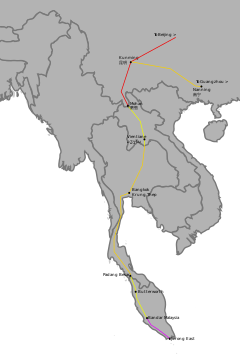 |
2.1.1 in China 中国段
- Kunming–Yuxi–Hekou railway, 388 km (241 mi) standard gaugerailway from Kunming to Hekou (via Yuxi and Mengzi, completed in 2014).
昆明-玉溪-河口铁路,全长388公里(241英里),标准轨距铁路,从昆明到河口(经过玉溪和蒙自,在2014年建成)。- Kunming–Hai Phong railway(Kunming-Hekou section), 465 km old metre gauge railway parallel to the newer railway, from Kunming to the Hekou Yao Autonomous County on the border with Vietnam (completed in 1910).
昆明-海防铁路(昆河段),全长465公里的旧米轨铁路与新铁路平行,从昆明到与越南接壤的河口瑶族自治县(于1910年完工)。
- Kunming–Hai Phong railway(Kunming-Hekou section), 465 km old metre gauge railway parallel to the newer railway, from Kunming to the Hekou Yao Autonomous County on the border with Vietnam (completed in 1910).
2.1.2 In Vietnam 越南段
- Kunming–Haiphong railway(Lao Cai-Haiphong section), metre gauge railway from Lao Cai, on the border with China, to Haiphong via Hanoi (completed in 1910).
昆明-海防铁路(老街-海防段),从中国边境的老街到海防,经过河内的米轨铁路(于1910年完工)。 - North–South railway of Vietnam, metre gauge railway from Hanoi to Ho Chi Minh City(completed in 1936).
越南南北铁路,自河内至胡志明市的米轨铁路(完成于1936年)。- North–South express railway of Vietnam, 1,570 km (980 mi) standard gauge, high-speed rail, from Hanoito Ho Chi Minh City (cancelled). This line was jointly planned by Vietnam and Japan using Shinkansen bullet train technology and financed in part by Japanese official development assistance. The project was scheduled to be built in stages from 2011 to 2020. In June 2010, Vietnam’s National Assembly rejected the plan due to high construction cost, reportedly equal to about 50 percent of the country’s GDP. However, the project will be re-considered during 2019 Vietnam’s National Assembly Session as Vietnam’s economy is growing much faster, thus significantly decreasing the project’s cost / GDP ratio.
越南的南北高速铁路,标准轨距为1,570公里,预计使用新干线子弹头列车技术,连接河内和胡志明市(已取消)。该项目是越南与日本共同策划,部分由日本官方发展援助资助。该项目计划从2011年到2020年分阶段建设。然而,由于建设成本过高,据报道相当于该国GDP的50%,2010年6月,越南国民议会拒绝了该计划。然而,随着越南经济增长速度加快,项目成本/GDP比率显著降低,该项目将在2019年越南国民议会会议期间重新考虑。
- North–South express railway of Vietnam, 1,570 km (980 mi) standard gauge, high-speed rail, from Hanoito Ho Chi Minh City (cancelled). This line was jointly planned by Vietnam and Japan using Shinkansen bullet train technology and financed in part by Japanese official development assistance. The project was scheduled to be built in stages from 2011 to 2020. In June 2010, Vietnam’s National Assembly rejected the plan due to high construction cost, reportedly equal to about 50 percent of the country’s GDP. However, the project will be re-considered during 2019 Vietnam’s National Assembly Session as Vietnam’s economy is growing much faster, thus significantly decreasing the project’s cost / GDP ratio.
- Ho Chi Minh City–Phnom Penh railway, 250 km (160 mi). This stretch of railway has never been built, and has been agreed to for feasibility studies by transport ministers from both Cambodia and Vietnam in 2020.[14]
- 胡志明市-金边铁路,全长250公里(160英里)。这段铁路从未建成,2020年两国交通部长同意进行可行性研究。[14]
2.1.3 In Laos 老挝段
- Savannakhet–Lao Bao railway, a 220 km (140 mi), electrified double track, high-speed railway from Savannakhetin Savannakhet Province, on the Thai border, to Lao Bảo in Vietnam’s Quảng Trị Province. The project costs US$4 billion and is being built by the Giant Consolidated of Malaysia.[15] A ground breaking ceremony was held in Ban Naxai on December 18, 2013.[16] This line will also be extended to the port city of Danang in Vietnam, and give landlocked Laos an outlet to the South China Sea.[16]
萨万纳贡-老街铁路,是一条220公里(140英里)的电气化双轨高速铁路,从萨万纳贡省的萨万纳贡(位于泰国边境)到越南广治省的老街。该项目耗资40亿美元,由马来西亚巨人集团建设。2013年12月18日,在那赛村举行了奠基仪式。该线路还将延伸至越南的岘港港口,为内陆国家老挝提供通往南海的出口。
2.1.4 In Cambodia 柬埔寨段
- The Phnom Penh–Poipetrailway, next to Aranyaprathet on the Thai border, was rebuilt and reopened on July 5, 2018. The original railway was destroyed in 1973 during the Cambodian Civil War.[17]
金边至波贝特铁路,位于泰国边境的阿兰亚普拉堤附近,于2018年7月5日重新修建并重新开放。原有的铁路在1973年柬埔寨内战期间被摧毁。 - The disconnected rail link from Phnom Penh to Ho Chi Minh City is being reconsidered. The cost for construction is estimated around US$600 million and the Chinese government will fund most proportion of construction. The Cambodian government will deal with the relocation of people who will be affected by the proposed new railway construction.
从金边到胡志明市的铁路断开的联系正在重新考虑。建设成本估计约为6亿美元,中国政府将资助大部分建设费用。柬埔寨政府将处理由拟议中的新铁路建设影响到的人口的搬迁问题。
2.1.5 In Thailand 泰国段
- Thailand’s Eastern Linerailway connects the border town Aranyaprathet with Bangkok.
泰国的东线铁路连接了边境城镇阿兰亚普拉捷与曼谷。
2.2 中线
于中华人民共和国的计划中,泛亚铁路中线从昆明到新加坡的国际铁路通道运营总里程4200公里,其中新建铁路1300公里,该线的主要优点是,从中国昆明至老挝、泰国、马来西亚及新加坡的运营里程最短,可兼顾东盟多个国家,对云南省开发农业、矿业、旅游资源作用较大。[来源请求]
泛亚铁路中线自昆明南站出发,经昆玉河铁路至玉溪站,沿玉磨铁路至西双版纳傣族自治州勐腊县磨憨站出境,经友谊隧道横越中老边境而进入老挝琅南塔省磨丁市,再沿磨万铁路前往老挝首都万象,跨过湄公河接驳曼谷-廊开高速铁路到达曼谷。
中线由以下铁路路线构成:
| 中线 – 100 km/h – 1,660 km | ||||||
| [隐藏]国家 | 线路 | 描述 | 设计速度(km/h) | 长度(km) | 轨距 | 开放日期 |
| 中国 | 昆明-玉溪 | 昆玉河铁路的一部分 | 200 | 106[4] | 标准轨 | 1993 |
| 玉溪-磨憨 | 连接玉溪与中老边境磨憨的线路 | 160 | 507 | 标准轨 | 2021 | |
| 老挝 | 磨丁-万象 | 老挝首条横跨全国的铁路线,从中老边境的磨丁到首都万象 | 160 | 422 | 标准轨 | 2021 |
| 塔纳楞-湄公河 | 老挝首条铁路线,从首都附近的塔纳楞站到泰国边境(湄公河) | 100 | 4 | 米轨 | 2009 | |
| 泰国 | 廊开-曼谷 | 泰国国铁东北线,连接首都曼谷与泰老边境的廊开 | ~100 | 623 | 米轨 | 1958 |
| 万象-呵叻 | 规划中的泰国东北高铁线(二期) | 250 | ~384 | 标准轨 | 未知 | |
| 呵叻-曼谷 | 建设中的泰国东北高铁线(一期),连接曼谷和呵叻 | 250 | 253 | 标准轨 | 2027 | |
中线由以下铁路路线构成:
2.2.1 In Laos 老挝段
- Boten–Vientiane railway, 421 km (262 mi) standard gauge line from Botenin Luang Namtha Province on the border with China, to Thanaleng, on the border with Thailand. This section opened in December 2021.[24][25][26]
从中国边境的兰纳塔省博腾到泰国边境的塔纳冷,全长421公里(262英里)的标准轨距铁路,名为博腾—万象铁路。该段铁路于2021年12月开通。
This line was originally planned as a high-speed rail joint-venture between the Laotian government and the China Railway Corporation, the Chinese state rail operator, and set to begin construction on 25 April 2011 but was delayed due to a corruption scandal that removed the Chinese railway minister, Liu Zhijun from office.[18] The Laotian government then became the sole investor in the project, which is funded with a loan from the Export-Import Bank of China that would cover 70 percent of the project’s cost of US$7 billion.[27][28][29] The project was downgraded to a conventional speed railway with a maximum speed of 160 km/h instead of 200 km/h.[28] As the terrain in Laos is mountainous, 76 bridges and 154 tunnels will need to be built.[28] Unexploded bombs that have been dropped during the Vietnam War will have to be removed.[21][23]
这条铁路最初计划由老挝政府和中国国家铁路运营商中国铁路总公司合资建设高速铁路,计划于2011年4月25日开始建设,但由于腐败丑闻导致中国铁路部长刘志军被撤职而延迟。随后,老挝政府成为该项目的唯一投资者,该项目由中国进出口银行提供贷款,覆盖项目总成本的70%(70亿美元)。该项目被降级为最高时速为160公里/小时的传统速度铁路。由于老挝地形多山,需要建造76座桥梁和154座隧道。还需清除越战期间投掷的未爆炸弹药。
The loan finance arrangement for this line was criticized by economists in the West as too expensive for Laos.[30] There is also controversy over villagers whose houses will be moved to accommodate the new railway line. One village, Bopiat in northern Laos, has already been moved once to allow the construction of a casino.[29][31] The National Assembly of Laos approved the project in October 2012, but the construction has not commenced because the Chinese state lender has been waiting since July 2013 for the Thai legislature to approve funding for the Thailand section of the railway line. On 22 July 2014, China’s Exim Bank suspended loans to Laotian infrastructure projects, leaving the rail project in jeopardy.[32] On 28 July 2014, at a meeting with Chinese Communist Party general secretary Xi Jinping in Beijing, Lao People’s Revolutionary Party general secretary Choummaly Sayasone asked the Chinese government to continue its assistance of rail development in Laos.[33]
这条铁路的贷款融资安排被西方经济学家批评为对老挝过于昂贵。此外,由于新铁路线需要移动房屋,村民们也存在争议。其中一个村庄,北老挝的Bopiat,已经为建设赌场而搬迁了一次。老挝国民议会于2012年10月批准了该项目,但由于中国国家贷款人自2013年7月以来一直在等待泰国立法机构批准该铁路线的泰国部分的资金,因此建设尚未开始。2014年7月22日,中国进出口银行暂停向老挝基础设施项目提供贷款,使铁路项目陷入危机。2014年7月28日,在北京与中国共产党总书记习近平会晤时,老挝人民革命党总书记周马利·萨伊苏恩要求中国政府继续援助老挝的铁路发展。
In October 2014, Radio Free Asia reported that China had made a new pledge to finance the project as talks between the two countries continued.[34]
2014年10月,自由亚洲电台报道称,中国在两国谈判继续进行的情况下,作出了新的资助该项目的承诺。
In January 2016, Singapore’s Straits Times reported that ground was broken on the project in December 2015.[35]
2016年1月,《海峡时报》报道称,该项目于2015年12月动工。
The first multiple unit train (EMU) was delivered to Vientiane on October 16, 2021, and the line opened on 3 December 2021.[36]
第一列多元化列车(EMU)于2021年10月16日交付给万象,并于2021年12月3日开通。[36]
2.2.2 In Thailand 泰国段
- Northeastern Line (Thailand), a metre gauge railway connecting Bangkok with Nong Khai. Currently in operation.
东北线(泰国),一条连接曼谷和农艾的米轨铁路。目前正在运营。- Bangkok–Nong Khai high-speed railway, a planned high-speed railway from Bangkok to Nong Khaion the border with Laos. As of 2020, 2 of the contracts for the Bangkok-Nakhon Ratchasima section is under construction, while the Nakhon Ratchasima–Nong Khai have yet to enter the bidding phase. Costs of this section was to be determined by February 2016 with construction starting in May 2016. When completed, eight-car, 613 passenger CRH2G[37] passenger trains will run on the line at a maximum speed of 250 km/h. At a speed of 180 km/h, it is estimated that passenger trains will run from Bangkok to Nong Khai in 230 minutes. HXD3B and HXD3C electric locomotives will be used to power freight trains travelling the line at 120 km/h.[24]
曼谷至廊开高速铁路是一条计划中的高速铁路,从曼谷一直延伸到与老挝接壤的廊开。截至2020年,曼谷至那空那育他段的两个合同正在建设中,而那空那育他至廊开的合同尚未进入招标阶段。该段的成本应该在2016年2月确定,建设将于2016年5月开始。当完成时,将有八节车厢、可载客613人的CRH2G客运列车在最高时速250公里的速度下运行。估计以每小时180公里的速度,乘客列车将在230分钟内从曼谷到达廊开。HXD3B和HXD3C电力机车将用于驱动以120公里/小时的速度行驶的货运列车。
- Bangkok–Nong Khai high-speed railway, a planned high-speed railway from Bangkok to Nong Khaion the border with Laos. As of 2020, 2 of the contracts for the Bangkok-Nakhon Ratchasima section is under construction, while the Nakhon Ratchasima–Nong Khai have yet to enter the bidding phase. Costs of this section was to be determined by February 2016 with construction starting in May 2016. When completed, eight-car, 613 passenger CRH2G[37] passenger trains will run on the line at a maximum speed of 250 km/h. At a speed of 180 km/h, it is estimated that passenger trains will run from Bangkok to Nong Khai in 230 minutes. HXD3B and HXD3C electric locomotives will be used to power freight trains travelling the line at 120 km/h.[24]
Planning for the high-speed line began during the administration of Prime Minister Abhisit Vejjajiva of the Democratic Party, which agreed to borrow US$400 million from China to purchase materials and expertise, and build one high speed line to Nong Khai Province to the north and another to the Padang Basar on the Malaysian border to the south.[38] When Prime Minister Yingluck Shinawatra of the Puea Thai Party took office in August 2011, the Thai government initially scaled back those plans and proposed shorter lines that connected Thai cities but did not reach international frontiers.[38] Supoj Sablorm, the secretary of the Thai Ministry of Transport, explained that Thailand was not in a rush to build a high-speed rail line to Laos because the Chinese-backed project in Laos had been delayed to beyond 2014.[38] A year later in August 2012, the Thai government announced the plans to build four high-speed rail lines, including extensions to Nong Khai and Hat Yai by 2022.[39] In October 2013, Chinese Premier Li Keqiang, on a visit to Thailand, promoted Chinese high-speed rail technology and offered loan packages for high-speed rail construction that are partially repayable with rice and rubber.[40]
高速铁路计划始于民主党总理阿披实·维查吉瓦的任期,该党同意从中国借款4亿美元购买材料和专业知识,并建造一条高速铁路线连接北部的廊开和南部的巴沙。当Puea Thai党的总理英拉·信武拉塔于2011年8月上任时,泰国政府最初缩减了这些计划,并提出了连接泰国城市但不到国际边境的较短路线。泰国交通部秘书Supoj Sablorm解释说,泰国不急于建造通往老挝的高速铁路,因为老挝的中国支持项目已经推迟到2014年以后。一年后的2012年8月,泰国政府宣布计划建造四条高速铁路线,包括到2022年将廊开和合艾扩展的路线。2013年10月,中国总理李克强在访问泰国时推广中国的高速铁路技术,并提供部分可用大米和橡胶偿还的高速铁路建设贷款。
On 19 November 2013, the Thai Senate passed a bill that authorized the government to borrow US$69.5 billion to fund high-speed rail and other infrastructure projects in Thailand without going through the annual government budgeting process.[41] The opposition Democratic Party challenged the spending bill in court and a judge expressed doubt about the necessity of high-speed rail for Thailand.[42] The ensuing political protests in Bangkok, which began in December 2013 and continued through May 2014, has paralyzed the Thai government and prevented further decision-making of the rail project.
2013年11月19日,泰国参议院通过了一项法案,授权政府借款695亿美元,用于在泰国建设高速铁路和其他基础设施项目,而无需经过年度政府预算程序。反对党民主党在法庭上挑战了这项支出法案,一位法官对泰国是否需要高速铁路表示怀疑。随后在曼谷爆发的政治抗议活动从2013年12月持续到2014年5月,瘫痪了泰国政府,并阻止了铁路项目的进一步决策。
On 30 July 2014, Thai army chief General Prayut Chan-o-cha, whose forces seized control of the government through a bloodless coup in May, announced plans to build two high-speed rail lines as part of a 741.4 billion baht transportation program.[43] The Nong Khai to Map Ta Phut line, 737 kilometres (458 mi) in length, would run from the Laotian border at Thanaleng to the Gulf of Thailand.[43] The Chiang Khong to Ban Phachi line, 655 kilometres (407 mi) in length, would run from Chiang Rai near the northern tip of Thailand to Ayutthaya just north of Bangkok.[43] The two lines would allow trains to travel at a top speed of 160 km/h.[43] Construction is scheduled to begin in 2015 and is to be completed in 2021.[43]
2014年7月30日,泰国军队总司令Prayut Chan-o-cha宣布计划建造两条高速铁路线,作为7414亿泰铢交通计划的一部分。从Nong Khai到Map Ta Phut的线路全长737公里,将从Thanaleng的老挝边境一直延伸到泰国湾。从Chiang Khong到Ban Phachi的线路全长655公里,将从泰国北端的清莱一直延伸到曼谷北部的大城Ayutthaya。这两条线路将使火车以最高时速160公里行驶。建设计划于2015年开始,预计于2021年完工。
In November 2014, after a meeting between Li Keqiang and Prayut Chan-o-cha, China agreed to lend Thailand funds to build dual-track standard gauge mid-speed railways on the Bangkok-Nong Khai, Bangkok-Map Ta Phut, and Kaeng Khoi–Map Ta Phut routes.[44] The loans could be repaid with rice and rubber.[44] On 4 December 2014, the Thai National Legislative Assembly voted 187–0 with seven abstentions to approve loans for the Nong Khai-Map Ta Phut and Kaeng Khoi-Bangkok lines.[45] China would undertake construction and development of the lines but would not receive land use rights along the routes.[45] On 19 December 2014, the two countries signed a memorandum to build the railways.[46]
2014年11月,李克强和巴育会面后,中国同意向泰国提供资金,用于在曼谷-廊开、曼谷-马帕塔布和坑锅-马帕塔布路线上建设双轨标准轨中速铁路。这些贷款可以以大米和橡胶偿还。2014年12月4日,泰国国民立法议会以187票赞成、7票弃权的投票结果通过了向曼谷-廊开和坑锅-曼谷线路提供贷款的决议。中国将承担线路的建设和开发,但不会在沿线获得土地使用权。2014年12月19日,两国签署了建设铁路的备忘录。
As of December 2015, China and Thailand have agreed to build the 845 km double-track rail routes connecting Bangkok–Kaeng Khoi–Nakhon Ratchasima–Khon Kaen–Udon Thani–Nong Khai and a second section connecting Kaeng Khoi–Map Ta Phut. The two parties have not yet reached agreement on financing for the project.[24]
截至2015年12月,中国和泰国已同意建造连接曼谷-加肯凯-那空那育-孔敬-乌汶-廊开的845公里双轨铁路路线,以及连接加肯凯-曼普塔普的第二段铁路。双方尚未就项目融资达成一致。
In March 2020, the Thai government committed to a US$21 billion railway expansion plan that will include a high speed rail from China to Singapore through Bangkok via the Laotian border near Vientiane.[47]
参考译文:2020年3月,泰国政府承诺了一项价值210亿美元的铁路扩建计划,其中包括一条从中国到新加坡的高速铁路,通过万象附近的老挝边境经过曼谷。
As of March 2021, the proposed completion of the high speed section from Bangkok to Nakhon Ratchasima is early 2027. The section from Nakhon Ratchasima to Nong Khai has not been bid. However, the lines do lie along an existing line primarily used for freight so no additional land will need to be appropriated.[48]
参考译文:截至2021年3月,从曼谷到那空那育他已经计划于2027年初完成高速铁路段。从那空那育他到廊开还没有进行招标。然而,这些线路沿用了主要用于货运的现有线路,因此不需要额外征用土地。
2.3 西线
中国境内主要为大瑞铁路和昆楚大铁路,经保山至瑞丽出境,长度为478公里,桥隧比约52%。形成昆明至新加坡运营总里程4900公里,其中新建路线970公里。该线主要优点是,沿线矿产资源种类较多,口岸贸易量大。主要问题是地形起伏较大,工程较为艰巨。[来源请求]
西线由以下铁路路线构成:
| 西线 – 24 km/h – 2,670 km | ||||||
| 国家 | 线路 | 描述 | 设计速度(km/h) | 长度(km) | 轨距 | 开放日期 |
| 中国 | 昆明-大理 | 昆明至大理的复线线路 | 200 | 328 | 标准轨 | 2018 |
| 大理-瑞丽 | 140 | 330 | 标准轨 | 2025-2027 | ||
| 缅甸 | 木姐-腊戌 | 将缅甸现有铁路延伸至木姐中国边境的拟建线路 | 未知 | ~120 | 未知 | 未建 |
| 腊戌-曼德勒 | 国家铁路系统的一部分 | ~24 | 441 | 米轨 | 1905 | |
| 曼德勒-仰光 | ~24 | 620 | 米轨 | 1889 | ||
| 仰光-丹彪扎亚 | ~24 | ~350 | 米轨 | 1942 | ||
| 泰国 | 丹彪扎亚-赛育县 | 原泰缅铁路的一部分,现已废弃。 | 未知 | ~285 | 米轨 | 废弃 |
| 赛育县-曼谷 | 原泰缅铁路的一部分,于1957年修复并被划入泰国南线支线铁路。 | 未知 | 194 | 米轨 | 1957 | |
2.3.1 In Myanmar 缅甸段
- Kunming–Yangon railway (Myanmar section), from Musein the Shan State on the border with China to Yangon with maximum train speeds of 170–200 km/h.
昆明-仰光铁路(缅甸段),从与中国接壤的掸邦木姐到仰光,最高时速为170-200公里/小时。
The Kunming–Yangon high-speed railway forms a portion of the 1,215 km (755 mi) high-speed railway from Kunming to Rakhine State on the Bay of Bengal.[49]
昆明-仰光高速铁路是昆仑至孟加拉湾拉钦邦1,215公里(755英里)高速铁路的一部分。
In late November 2010, Chinese state media reported that the railway would begin construction in about two months.[50] But in March 2011, the Chinese Commerce Minister Chen Deming stated that the project was delayed due to the first elections in Myanmar in 20 years and differences in the railway gauge of the two countries.[51] He explained the Chinese rail developers were waiting for the new cabinet in Myanmar to form and expressed hope that work on the line would begin before the end of 2011.[51] On 18 July 2014, the Myanmar government cancelled the project, citing opposition from civil rights groups, villagers and the general public.[49]
2010年11月底,中国国家媒体报道称,铁路将在大约两个月内开始建设。但是在2011年3月,中国商务部长陈德铭表示,该项目因缅甸20年来的首次选举和两国铁路轨距的差异而被延迟。他解释说,中国的铁路开发商正在等待缅甸新内阁组建,并希望在2011年底之前开始铁路建设工作。2014年7月18日,缅甸政府取消了该项目,称受到民权组织、村民和公众的反对。
In the summer of 2018, plans for the China-Myanmar railway were resumed. [52]
2018年夏季,中缅铁路的计划得以恢复。
- Yangon–Myitkyina railway, from Yangon to Myitkyina, near the border with China (existing railway). 从仰光到密支那的仰光-密支那铁路,靠近与中国的边境(现有铁路)。
In December 2013, the Myanmar government began to discuss the upgrade of the existing Yangon-Myitkyina railway with the Asian Development Bank and the government of South Korea.[53]
2013年12月,缅甸政府开始与亚洲开发银行和韩国政府讨论升级现有的仰光至密支那铁路。
- Yangon–Mandalay railway, from Yangon to Mandalay(existing railway).
从仰光到曼德勒的仰光-曼德勒铁路(现有铁路)。
In December 2013, Japanese media reported that the Myanmar and Japanese governments had reached an agreement to upgrade this line.[53]
2013年12月,日本媒体报道称,缅甸和日本政府已达成协议,升级该线路。
- Former Burma Railway既有的缅甸铁路
In May 2012, the railway Minister Aung Min of Myanmar announced that a feasibility study would be undertaken to rebuild the 105-km stretch of the Thai–Burma railway from the Three Pagoda Pass to the Thai border.[54] The railway could be reopened, he said, with international assistance and promote development in the region and peace with ethnic Shan and Karen rebels in the border areas.[54]
2012年5月,缅甸铁路部长Aung Min宣布将进行可行性研究,重建从三宝达通往泰国边境的105公里泰缅铁路。他表示,国际援助可以重新开放铁路,促进该地区的发展,以及与边境地区的掸族和克伦族叛军实现和平。
2.3.2 In Thailand 泰国段
- Parts of the Burma Railwayare still in operation, connecting Nam Tok in western Thailand with Bangkok.
缅甸铁路的部分仍在运营,连接泰国西部的南索克和曼谷。
2.4 曼谷-新加坡段
曼谷-新加坡段已有现成普速铁路。2020年底,原计划的吉隆坡-新加坡高速铁路被马来西亚方面宣布取消。
这段铁路由以下路线构成:
| 曼谷~新加坡段 – 100 km/h – 1,940 km | ||||||
| 国家 | 线路 | 描述 | 设计速度(km/h) | 长度(km) | 轨距 | 开放日期 |
| 泰国 | 曼谷-合艾-巴东勿刹 | 泰国南线铁路,连接曼谷与泰马边境巴东勿刹镇 | ~100 | 974 | 米轨 | 1918 |
| 马来西亚 | 巴东勿刹-金马士 | 马来西亚的西海岸线,最初于1896年左右完成,自2014年起电气化并由马来亚铁道电动列车服务 (KTM ETS) 服务运行 | 140 | 755 | 米轨 | c.1896 |
| 金马士-新山 | 马来西亚的西海岸线,目前由马来亚铁道城际铁路运营,预计于2022年实现电气化并由马来亚铁道电动列车服务 (KTM ETS) 服务运营 | 110 | 197 | 米轨 | c.1896 | |
| 新加坡 | 新山-新加坡 | 往返于柔佛州新山和新加坡的穿梭线路 | 110 | ~10 | 米轨 | 1903 |
2.4.1 In Thailand 泰国段
- Southern Line (Thailand), a metre gauge railway connecting Bangkok with Hat Yai, with a branch line leading to Padang Besaron the Thailand-Malaysian border. Currently in operation.
南线(泰国),一条连接曼谷和合艾的米轨铁路,还有一条支线通往泰国-马来西亚边境的巴当倍加。目前正在运营中。
2.4.2 In Malaysia and Singapore 马来西亚-新加坡段
- KTM West Coast railway line, a metre gauge railway connecting Padang Besarwith Kuala Lumpur and Johor Bahru, stretching across the entire Malaysian west coast. A shuttle service links Johor Bahru and Singapore’s Woodlands Train Checkpoint.
KTM西海岸铁路线是一条米轨铁路,连接巴达兴披沙和吉隆坡、柔佛新山,贯穿整个马来西亚西海岸。班车服务连接新山和新加坡的兀兰火车关卡。
The KTM line from Padang Besar to Gemas was electrified and double tracked in 2015, and upgrade works from Gemas to Johor Bahru are expected to be completed by October 2022, bringing down journey times from Woodlands North in Singapore to KL Sentral to about 4 hours.[55][56]
2015年,从巴东巴萨到吉马士的KTM线路进行了电气化和双轨改造,预计到2022年10月,从吉马士到新山的升级工程将完成,将从新加坡木兰北到吉隆坡中环的旅行时间缩短到约4小时。
According to PLANMalaysia, a northern high-speed rail corridor will be built along North-South Expressway and the stations will be at Tanjung Malim, Tapah, Ipoh, Taiping and terminated at Butterworth.[57]
根据PLANMalaysia的说法,一条北部高速铁路走廊将沿着南北大道建造,车站将设在丹绒马林,打巴,怡保,太平,并以峇六拜结束。
3. 取消的高速铁路计划 | Cancelled high-speed rail plan
In 2013, the governments of Malaysia and Singapore agreed to build a Kuala Lumpur-Singapore High Speed Rail from Kuala Lumpur to Singapore that was scheduled to open in 2026. But shortly after winning the May 2018 election, the incoming Malaysian prime minister, Mahathir Mohamad said he would reconsider the project.[58][59] Among revisions being explored to reduce costs, was to align the route to the existing meter gauge Keretapi Tanah Melayu (KTM) line and lay a standard gauge track in parallel, with a fork running to Jurong East so that bilateral agreement is not violated, to allow trains running at 200 km/h, cutting journey time between Kuala Lumpur and Singapore to 130 minutes.[60] Stations were planned for Bandar Malaysia in Kuala Lumpur, Bangi–Putrajaya, Labu (Seremban), Muar, Batu Pahat, Iskandar Puteri and Jurong East. The plan has been cancelled after 2 extensions requested by Malaysia, with the project allowed to lapse on 31 December 2020.[61]
参考译文:2013年,马来西亚和新加坡政府同意建造一条从吉隆坡到新加坡的高速铁路,计划于2026年开通。但在赢得2018年5月选举后不久,新上任的马来西亚总理马哈蒂尔·穆罕默德表示将重新考虑这个项目。[58][59] 正在探讨的修改方案包括将路线与现有的Keretapi Tanah Melayu(KTM)米轨线路对齐,并平行铺设标准轨距轨道,叉路通往裕廊东,以避免违反双边协议,让列车以200公里/小时的速度行驶,将吉隆坡和新加坡之间的旅行时间缩短至130分钟。[60] 站点计划设在吉隆坡的万达城、万宜-布城、Labu(芙蓉)、Muar、峇株巴辖、依斯干达普特里和裕廊东。该计划已经在马来西亚提出两次延期后取消,该项目将于2020年12月31日失效。[61]
参考文献
(1)中文词条
- 泛亚铁路网政府间协定 (PDF). 联合国亚洲及太平洋经济社会委员会. 2011-06-15 [2019-09-19].
(2)英文词条
- Mahitthirook, Amornrat. Bangkok set to be China’s rail hub. Bangkok Post. 2015-12-28 [30 December2015].
- SE-Asia railway idea revived. BBC. 2001-11-04 [2021-12-10]. (原始内容存档于2021-12-10) (英语).
- Kakizaki, Ichirō. Laying the Tracks: The Thai Economy and Its Railways 1885-1935. Kyoto University Press. 2005: 113 [2022-05-05]. ISBN 978-1-920901-02-8. (原始内容存档于2022-05-05) (英语).
- 中老铁路12月3日全线开通运营 昆明至万象约10小时可达. 中国新闻网. 2021-12-02 [2022-05-05]. (原始内容存档于2021-12-03).
- The Singapore-Kunming rail link project(PDF). 东盟. 2007-09-26 [2021-12-06]. (原始内容 (PDF)存档于2007-10-09).
- SINGAPORE – KUNMING RAIL LINK(PDF). 联合国亚洲及太平洋经济社会委员会. 2015-03-13.
- 数据简报:泛亚铁路的由来与现状. 中国经济网. 2013-10-21 [2019-09-19]. (原始内容存档于2015-10-05).
- 泛亚铁路网政府间协定(PDF). 联合国秘书处. 2009-06-11 [2021-12-06]. (原始内容存档 (PDF)于2021-12-06).
参见

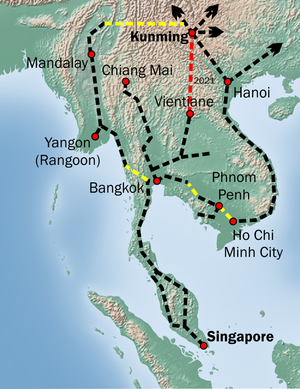
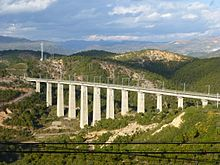
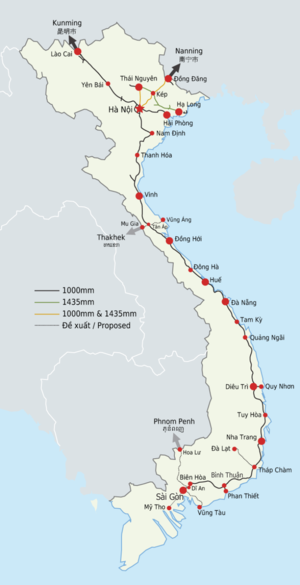


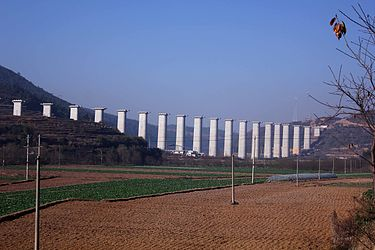
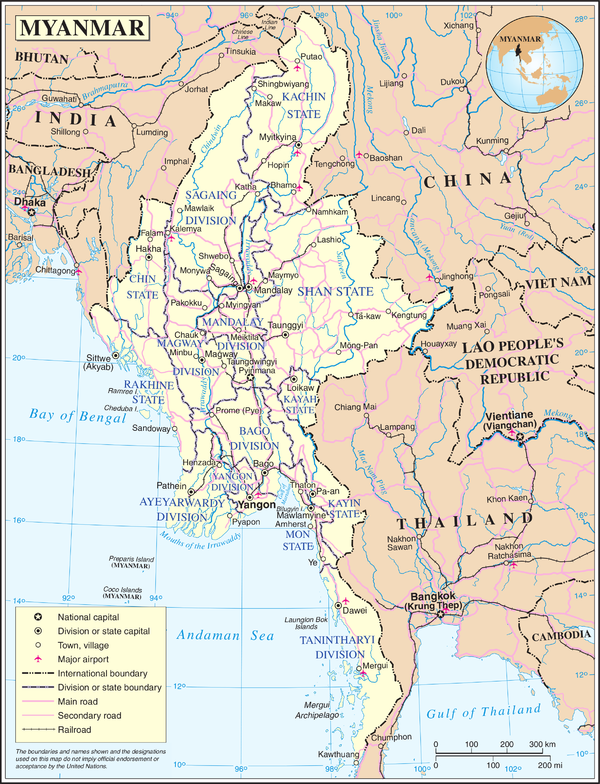
分享到: